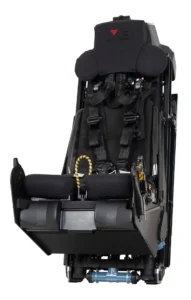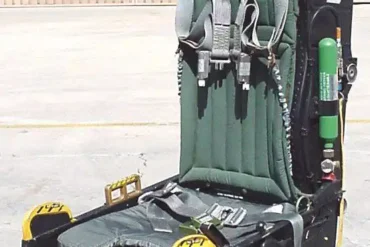The F-16 Fighting Falcon, one of the most widely used combat aircraft globally, has undergone numerous upgrades since its inception. Among the most crucial enhancements is the ejection seat system. This critical component ensures the safety and survival of aircrews in emergencies, allowing them to escape the aircraft in extreme conditions. The latest advancement in this area is the US18E ejection seat, designed to replace the older legacy seat in the F-16 Block 70/72 series. Manufactured by Martin-Baker, this next-generation ejection seat delivers unparalleled safety features, operational efficiency, and versatility, revolutionizing how aircrew are protected in high-speed, high-risk combat environments.
Understanding the F-16 Ejection Seat
The ejection seat is a life-saving mechanism that allows a pilot to safely exit the aircraft in the event of an emergency. These seats are equipped with a series of sophisticated technologies that ensure safe ejection from an aircraft, even under the most extreme conditions, including high altitudes and speeds. The F-16 ejection seat is a critical component of the aircraft’s safety system, and with the introduction of the US18E, the level of protection has reached unprecedented heights.
The US18E ejection seat is based on the successful US16E seat used in the F-35, Lockheed Martin’s fifth-generation fighter. Martin-Baker’s decades of expertise in ejection seat technology have been distilled into the design of this new seat, ensuring it offers superior safety, comfort, and efficiency for aircrews.
Why the F-16 Block 70/72 Chose the US18E Ejection Seat
In November 2020, Lockheed Martin made a significant decision to replace the legacy ejection seat in the F-16 Block 70/72 aircraft with the US18E. This decision was a critical step forward in enhancing the operational capabilities and safety of the aircraft. The legacy seat, while effective, did not meet the evolving requirements of modern aircrew, especially in terms of weight range, accommodation flexibility, and compatibility with advanced technologies such as Helmet Mounted Displays (HMD).
The US18E’s selection was part of a broader initiative to modernize the F-16 Block 70/72 and align it with the latest technological advancements found in other contemporary military aircraft. This upgrade not only improves safety but also reduces maintenance time and costs, making it a game-changer for air forces worldwide.

Key Features of the US18E Ejection Seat
The US18E ejection seat brings a host of innovations that set it apart from its predecessors. These features ensure that the seat can accommodate a broader range of aircrews, deliver improved safety during ejection, and streamline maintenance processes for operators. Let’s take a closer look at the defining features of the US18E.
1. Wider Weight Range
One of the most significant advantages of the US18E is its expanded weight range. The seat is capable of accommodating aircrew members weighing between 103 lbs and 245 lbs, a considerable improvement over the legacy seat. This broader weight range ensures that a wider range of pilots, including those who might have previously been excluded due to their size, can safely egress the aircraft in emergencies.
2. Gender-Neutral Accommodation
The US18E ejection seat offers enhanced ergonomics to support a diverse range of aircrew members. The seat’s CAESAR multivariate Case 1 accommodation system allows for a much broader range of body types, ensuring that the seat is gender-neutral. This means that the seat can be effectively used by both male and female aircrew, significantly improving operational flexibility and inclusivity.
3. Safe Ejection with Helmet-Mounted Displays
Modern fighter jets like the F-16 Block 70/72 are often equipped with Helmet Mounted Displays (HMDs), which are critical for situational awareness during combat. However, these displays can sometimes complicate safe ejection if not properly integrated with the seat system. The US18E has been specifically designed to ensure that aircrew equipped with HMDs can safely eject from the aircraft, even under extreme speed and altitude conditions. This integration makes the ejection system more versatile and effective in modern combat environments.
4. Redundancy with Electronic and Mechanical Systems
The US18E ejection seat features a Martin-Baker Electronic sequencer, which manages the sequence of events during ejection. This electronic system is paired with a mechanical automatic backup unit, providing redundancy to ensure that the seat will function even in the unlikely event of an electronic failure. This dual-system approach increases the reliability of the ejection seat, which is a vital factor in ensuring aircrew safety.
5. Modular Design for Easier Maintenance
Maintenance is a critical aspect of any military aircraft, and the US18E ejection seat has been designed with this in mind. Its modular design significantly reduces the need for canopy removals, a process that typically consumes considerable time and resources. By simplifying the maintenance process, the US18E reduces the number of hours operators need to spend on upkeep, allowing for more efficient turnaround times for the F-16.
6. Compatibility with F-35/US16E Systems
Lockheed Martin’s decision to use the US18E seat in the F-16 Block 70/72 series was driven by the desire to leverage existing systems and technologies. The US18E shares many common parts, support equipment, and procedures with the F-35 and the US16E seat used in that aircraft. This commonality helps streamline logistics and ensures that air forces can support both aircraft types using similar resources, reducing operational costs and complexity.
Technical Specifications of the US18E Ejection Seat
The US18E ejection seat is not just a safety device but also a highly sophisticated system engineered to perform under extreme conditions. Here are some key technical specifications that demonstrate its capabilities:
- Operating Ceiling: 55,500 ft (16,768 m), which ensures the seat can function at the altitudes that fighter pilots may reach during combat operations.
- Minimum Height/Speed: The seat is designed for Zero/Zero ejection in a near-level attitude, meaning it can be deployed in situations where the aircraft is at a low altitude and low speed, offering maximum flexibility in emergency situations.
- Crew Size Range: The seat is designed to accommodate aircrew members from the CAESAR Case 1 to the 95th percentile, ensuring that it can fit a wide range of body types.
- Maximum Speed for Ejection: The US18E can safely eject an aircrew member at speeds up to 600 KEAS (Knots Equivalent Airspeed), which is an extremely high speed and demonstrates the seat’s capability in high-stress flight conditions.
- Parachute Type: The seat uses the IGQ 6000 parachute system, which is specially designed for high-speed ejection scenarios.
- Harness Type: The MG5 Integrated Harness ensures that the aircrew is securely held in place during ejection, reducing the risk of injury.
- Ejection Gun: The seat uses a Twin Catapult system for ejection, which ensures a powerful and reliable launch from the aircraft.
- Automatic Backup Unit: The seat features an automatic backup system to ensure the ejection sequence is completed even if the primary electronic system fails.
Why the US18E is a Game-Changer for F-16 Pilots
The US18E ejection seat represents a major leap forward in ejection seat technology. Its advanced features ensure that the F-16 Block 70/72 is equipped with one of the safest and most reliable ejection seat systems available. With a broader range of accommodations, integration with modern technologies, and a design that minimizes maintenance requirements, the US18E will undoubtedly play a key role in safeguarding F-16 pilots for decades to come.
As military aircraft continue to evolve and engage in increasingly complex operations, the US18E ejection seat stands as a testament to the ongoing commitment to aircrew safety and operational excellence. The seat’s combination of modern design, advanced features, and compatibility with existing systems ensures that it will remain a key component in the safety infrastructure of modern air forces worldwide.
Conclusion
The US18E ejection seat is an indispensable upgrade for the F-16 Block 70/72, offering a range of benefits that improve aircrew safety, reduce maintenance requirements, and enhance operational flexibility. With its advanced features and technical specifications, it represents the next step in the evolution of ejection seat technology, ensuring that F-16 pilots are protected during even the most extreme combat scenarios. As air forces continue to prioritize pilot safety and mission success, the US18E will undoubtedly remain a cornerstone of ejection seat technology for years to come.

